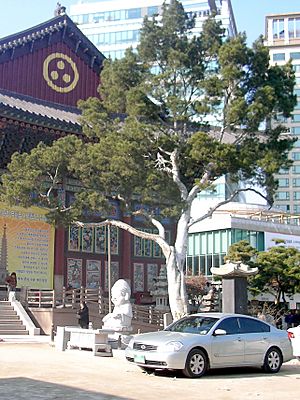Lacebark pine facts for kids
Quick facts for kids Lacebark pine |
|
|---|---|
 |
|
| Lacebark pine to the east of the Main Hall at Jogyesa (Buddhist Temple) in Seoul, South Korea | |
| Conservation status | |
| Scientific classification | |
| Genus: |
Pinus
|
| Species: |
bungeana
|
The Lacebark Pine (scientific name: Pinus bungeana) is a special type of pine tree. It is also known as Bunge's pine or white-barked pine. This tree originally comes from the mountains of northeastern and central China.
It grows quite slowly but can reach heights of 15 to 25 meters (about 50 to 82 feet). The Lacebark Pine is very strong and can survive cold temperatures, even below -26°C (-15°F). Its most amazing feature is its bark, which changes color as it gets older.
Contents
Discovering the Lacebark Pine
The Lacebark Pine has smooth, grey-green bark when it is young. As the tree grows, this outer bark starts to peel off in round pieces. This reveals beautiful patches of pale yellow underneath. These new patches then change to olive-brown, red, and even purple when they are exposed to sunlight. This colorful, peeling bark makes the tree look like it has a "lace" pattern, which is how it got its name.
Where Lacebark Pines Grow
Lacebark Pines are naturally found in the mountain areas of China. However, people love to plant them in other places too because of their unique and pretty bark. They are often grown as ornamental trees in gardens around the world.
These trees have even started to grow on their own in new places. For example, they have become naturalized in the Sierra de la Ventana mountains in eastern Argentina. This means they are now growing there without human help.
Why Lacebark Pines Are Special
Lacebark Pines are very popular in gardens, especially those designed to look like traditional Chinese gardens. In Chinese culture, these trees are a symbol of a long life. They are often seen growing with many stems, which adds to their interesting look.
You can also find these beautiful trees in many botanic gardens. People enjoy their unique appearance, especially their colorful, peeling bark.
Images for kids
-
Lacebark pine at Kew Gardens, London, England
See also
 In Spanish: Pino chino de Bunges para niños
In Spanish: Pino chino de Bunges para niños






